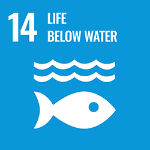About Life below Water
Conserve and sustainably use the oceans, seas and marine resources for sustainable development.

We work towards the UN's Sustainable Development Goal 14: Life below Water, to create a better and fairer world.
The 2030 Agenda for Sustainable Development was adopted in 2015 by all United Nations member states. It provides a blueprint for peace and prosperity for people and the planet.
Find out more about our work across all the UN's Sustainable Development Goals.
Conserve and sustainably use the oceans, seas and marine resources for sustainable development.

The Forth Environmental Resilience Array (Forth-ERA) is the first of its kind; a digital observatory of the Firth of Forth’s entire water catchment. The observatory provides a living laboratory providing real-time and near real-time environmental data and analytics, which can facilitate world-leading scientific research, promote more efficient environmental management and regulation, and stimulate business innovation in support of Scotland’s transition to net zero.
The innovative approach of Forth-ERA will be transformative, driving sustainable economic recovery on a local, regional and ultimately global scale.
Bringing Scotland’s water sector together to drive us to net zero and beyond, Scotland Hydro Nation Chair, hosted by the University of Stirling, is leading the collaboration needed to deliver sustainable water management in Scotland.
The project is working across the Scottish water sector and its supply chain to eliminate emissions from infrastructure development and waste water processing, promote our natural environment and manage our processes better, allowing us to recover resource including energy to contribute to a greener, more circular economy.
The ReSOW UK project is generating a step-change in our understanding of the contribution of seagrass to the UK’s environmental security, economy and wellbeing. It is applying a holistic, systems-based approach which integrates understanding of environmental functioning with the various priorities of those who use, or benefit from, the coast.
The project will inform interventions for the management of seagrass which align with local, national and international priorities, yet that are inclusive of the needs of multiple stakeholders and geared towards the long-term sustainability of coastal communities.
The Institute of Aquaculture (IoA) is an international centre in aquaculture and the largest of its kind in the world. It leads the world in a vision to tackle global problems of food security, hunger and sustainability through aquaculture. This has been recognised through the award of the Queen’s Anniversary Prize.
IoA has an international reputation for teaching, world-class research, technological innovation and consultancy in aquaculture. IoA’s degrees teach students about all subjects relevant to global aquaculture, including the culture of many species, such as crocodiles and turtles. IoA teaches students everything they need to know for a career in aquaculture, marine biology, and related areas such as pharmacy and biotechnology.
People and The Environment is a first-year module that introduces students to the concepts of sustainability, the environment as a holistic working system and the patterns of human resource use. The module develops and explores these concepts and provides students with an understanding of the underpinning, scientific fundamentals.
Students explore sustainability through four key themes:
Our Masters in Sustainable Aquaculture explores the principles of aquaculture and the key factors influencing the viability of aquatic animal farming and food production systems. Students will develop an understanding of aquatic animal biology, environmental issues, nutrition, reproduction and genetics, disease and health management. Students also have the opportunity to explore the commercial business of sustainable aquaculture, with optional modules covering marketing, business studies and economics.
Ultrasonic sound wave units were installed in the University’s Airthrey Loch to provide a permanent solution to the recurring cyanobacteria (blue green algae) issue. These emit ultrasonic waves which create pressure in the top layer of the water which prevent algae from surfacing and absorbing light for photosynthesis. Algae then fall to the loch bed where they are degraded by bacteria.
The units offer a non-chemical means for eliminating or mitigating algae without any detrimental effect to fish, plants, zooplankton or insects.
Part of the University’s Institute of Aquaculture (IoA), NATIH will lead the development and deployment of the new technologies and systems required to support growth in the production of aquatic food for human consumption, while reducing the impact on natural resources.
NATIH is funded by a £17 million investment by the UK Government through the Stirling and Clackmannanshire City Region Deal, as well as a £1 million Wolfson Foundation grant.
Project SenseH2O is a scalable, integrated systems-based approach to monitoring water quality from headwaters to river outlets. This is a University-led consortium collaborating with the University of Glasgow and Scotland's Innovation Centre for sensing, imaging and Internet of Things (IoT) technologies (CENSIS). This is supported by SEPA and Scottish Water and has capital funding to develop a new system for lower-cost monitoring of water quality.
Building on existing work in Forth-ERA, the project will develop a new extensive sensing system for freshwater quality with AI data analytics and web-based visualisation that can be scaled and commercialised.
As part of the University’s Forth-ERA programme, the University installed buoys on water bodies across the Forth Valley area including Carron Valley Reservoir, Linlithgow Loch and Gartmorn Dam.
The floating data buoys, which are almost two metres tall, have state-of-the-art sensors which can measure water quality in near real-time, sending data over the mobile phone network so they can be accessed by scientists, governmental organisations, and local communities.
In addition to water quality, Forth-ERA will also support improved monitoring of biodiversity, floods and droughts, and air quality. Ultimately, this work will deliver a sustainable and just transition to a net zero future.